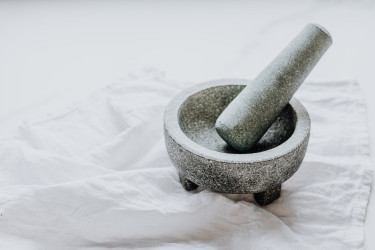Resourceful Herb Grinding with Kitchen Tools
Are you tired of spending money on fancy herb grinding tools? Do you want to make the most of the tools you already have in your kitchen? Look no further!
In this blog post, we will explore the art of resourceful herb grinding, where we will dive into the world of common kitchen tools and discover how they can be used to effectively grind herbs.
Whether you have a mortar and pestle, a coffee grinder, or even just a few basic kitchen utensils, we will show you how to make the most out of what you have. Get ready to elevate your herb grinding game and unlock the full potential of your available tools. Let's get started!
Exploring Common Tools for Herb Grinding
When it comes to herb grinding, there is a wide array of tools available to choose from. In this section, we will explore some of the most common tools used for grinding herbs and discuss their features, advantages, and limitations. Whether you have a mortar and pestle, a coffee grinder, a dedicated herb grinder, or just basic kitchen tools, we will guide you through the different options and help you make an informed choice for your herb grinding needs.
Related Article: Mamba Grinders™: Innovation and Grinding Excellence
Using a Mortar and Pestle

A mortar and pestle is a classic tool used for grinding herbs and spices. It consists of a bowl-shaped mortar and a pestle, which is a handheld grinding tool. Here are some key points to consider:
- Material: Mortars and pestles can be made of various materials such as stone, ceramic, or stainless steel. Each material has its own advantages in terms of durability, ease of cleaning, and grinding efficiency.
- Grinding Technique: With a mortar and pestle, you can crush and grind herbs by applying pressure and rotating the pestle in a circular motion. This method allows for more control over the consistency of the grind.
- Pros: Mortar and pestle provide a hands-on and traditional approach to herb grinding. They are versatile, easy to use, and can handle both small and large quantities of herbs.
- Cons: Grinding with a mortar and pestle can be time-consuming, especially when dealing with tougher herbs. It may also require more physical effort compared to other tools.
Related Article: Looking Ahead: Future Advancements in Herb Grinding
Grinding with a Coffee Grinder

A coffee grinder is a popular kitchen tool that can be repurposed for grinding herbs. Here's what you need to know about using a coffee grinder for herb grinding:
- Blade vs. Burr Grinder: Coffee grinders come in two main types: blade grinders and burr grinders. Blade grinders use spinning blades to chop herbs, while burr grinders crush them between two abrasive surfaces. Burr grinders are generally preferred for herb grinding as they provide a more consistent grind.
- Cleaning: It's important to thoroughly clean the coffee grinder before and after grinding herbs to prevent cross-contamination of flavors. Residual coffee oils can affect the taste of the herbs.
- Pros: Coffee grinders are affordable, widely available, and can produce a fine and consistent grind. They are also suitable for grinding larger quantities of herbs.
- Cons: Coffee grinders may not provide as much control over the grind consistency as other tools. Additionally, using a coffee grinder solely for herb grinding may result in residual flavors from previously ground coffee.
Utilizing an Herb Grinder
Dedicated herb grinders are specifically designed for grinding herbs and spices. Here's what you should know about using a herb grinder:
- Design and Features: Herb grinders typically consist of multiple compartments with sharp teeth or pegs that shred the herbs as they are rotated. Some herb grinders also have a pollen catcher or chamber for collecting the flavourful resinous crystals.
- Grinding Efficiency: Herb grinders are known for their efficiency in producing a fine and consistent grind. The multiple teeth or pegs ensure that the herbs are evenly shredded.
- Pros: Herb grinders offer convenience, speed, and precise control over the grind consistency. They are ideal for grinding herbs in larger quantities and are specifically designed for this purpose.
- Cons: Herb grinders may be an additional expense if you don't already own one. They are also more suitable for dry herbs and may not be as effective for grinding moist or fibrous herbs.
Related Article: Designing for Accessibility: The Herb Grinder Revolution
Improvising with Kitchen Tools
If you don't have a dedicated herb grinding tool, don't worry! You can still achieve satisfactory results by improvising with common kitchen tools. Here are a few options:
- Knife and Cutting Board: Finely chop the herbs using a sharp knife and a cutting board. This method requires manual dexterity and may not produce as consistent a grind as other tools.
- Rolling Pin: Place the herbs inside a plastic bag and use a rolling pin to roll and crush them. This technique can be effective for larger quantities of herbs.
- Food Processor: A food processor can be used to grind herbs, especially for larger quantities. However, be cautious as the speed and power of the processor can quickly turn the herbs into a paste if not monitored closely.
By exploring these common tools for herb grinding, you now have a better understanding of the options available to you.
Related Article: 15 Creative Ways To Grind Herbs Without a Grinder
Proper Cleaning and Maintenance of Grinding Tools
Proper cleaning and maintenance of your grinding tools are essential to ensure their longevity and optimal performance. In this section, we will discuss why regular cleaning is important, provide guidance on cleaning different types of grinders, and offer some maintenance tips to keep them in top shape.
Why Regular Cleaning is Essential
Regular cleaning of your grinding tools is crucial for several reasons:
- Hygiene: Cleaning removes any residual herbs, oils, or particles that may accumulate over time. Proper hygiene prevents the growth of bacteria and ensures that your herbs remain safe for consumption.
- Flavor Preservation: Cleaning prevents cross-contamination of flavors between different herbs. It ensures that the flavors of each herb remain distinct and unaltered, allowing you to enjoy their true taste.
- Performance Optimization: Over time, residue can build up in the grinding mechanism, affecting the efficiency and consistency of the grind. Regular cleaning ensures smooth operation and consistent results.
Cleaning Different Types of Grinders
The cleaning process may vary depending on the type of grinder you are using. Here are some guidelines for cleaning different types of grinders:
Mortar and Pestle:
- Rinse the mortar and pestle with warm water immediately after use to remove any loose particles.
- For stubborn residue, use a small brush or a toothbrush to gently scrub the surface.
- Avoid using harsh detergents or abrasive cleaners, as they may damage the material.
Coffee Grinder:
- Unplug the grinder and remove the hopper and any removable parts.
- Wipe away any loose coffee grounds with a dry cloth or brush.
- Clean the grinding chamber and blades using a damp cloth or a brush. Be careful not to get moisture near any electrical components.
- Allow all parts to dry completely before reassembling the grinder.
Herb Grinder:
- Disassemble the herb grinder, separating the different chambers.
- Use a small brush or toothbrush to remove any herb residue from the teeth and screens.
- Rinse each component with warm water and mild soap, ensuring thorough cleaning.
- Dry all parts completely before reassembling the grinder.
Maintenance Tips for Prolonged Use
To keep your grinding tools in optimal condition, consider the following maintenance tips:
- Regular Inspection: Periodically check your grinding tools for any signs of wear or damage. Replace any worn-out parts promptly to avoid compromising their performance.
- Lubrication: Some grinders, such as coffee grinders, may benefit from occasional lubrication of moving parts. Consult the manufacturer's guidelines for the appropriate lubricant to use.
- Storage: Store your grinding tools in a clean and dry area, away from moisture and direct sunlight. This helps prevent rusting, corrosion, and degradation of the materials.
- Sharpening: If your grinder's blades or teeth become dull over time, consider sharpeninga them to restore their cutting efficiency. Follow the manufacturer's instructions or seek professional assistance if necessary.
- Usage Tips: Use the appropriate grinding techniques for each herb and avoid overloading the grinder. This helps maintain the overall performance and longevity of the tool.
Making the Most of Your Available Tools for Herb Grinding
Resourceful herb grinding allows you to make the most of the tools you have available in your kitchen. Whether it's a mortar and pestle, a coffee grinder, or improvising with basic kitchen tools, you can elevate your herb grinding game and unlock the full potential of your herbs.
By understanding the basics, cleaning and maintaining your tools, grinding different types of herbs effectively, and optimizing storage, you can enhance your culinary creations and herbal preparations.
So, embrace the resourceful approach to herb grinding and let your available tools take you on a flavorful and aromatic journey. Happy herb grinding!


Leave a comment
Please note, comments must be approved before they are published